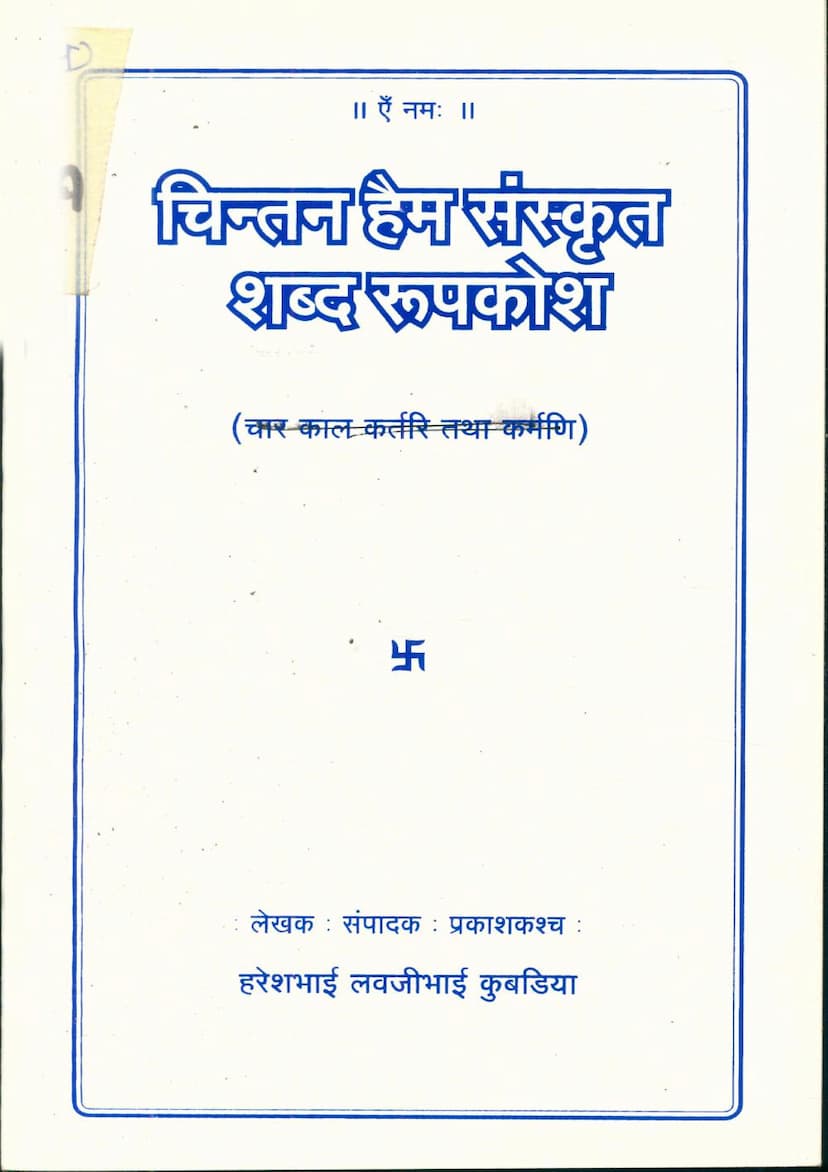Chintan Haim Sanskrit Shabda Rupkosh
Added to library: September 1, 2025

Summary
Here's a comprehensive summary of the Jain text "Chintan Haim Sanskrit Shabda Rupkosh" by Haresh L Kubadiya, based on the provided pages:
Title: Chintan Haim Sanskrit Shabda Rupkosh (चिन्तन हैम संस्कृत शब्दरूपकोश) Author, Editor, Publisher: Haresh L Kubadiya (हरेभाइ लवजीभाई कुबडिया) Publisher: Haresh L Kubadiya Catalog Link: https://jainqq.org/explore/002221/1
Overview:
"Chintan Haim Sanskrit Shabda Rupkosh" is a Sanskrit grammar book, specifically a lexicon of noun declensions (shabd rup) and verb conjugations (kaal kartari tatha karmani). The title itself indicates a focus on "Chintan Haim," suggesting a connection to a lineage or teachings possibly related to "Haim" (likely referring to Hemachandra, a prominent Jain scholar of Sanskrit grammar). The book aims to provide a comprehensive guide to the grammatical forms of Sanskrit words, covering various genders, cases, and tenses.
Key Features and Content:
- Scope of Sanskrit Grammar: The book meticulously covers the formation of noun declensions for masculine (Pumlinga), feminine (Strilinga), and neuter (Napumsakalinga) genders. It also includes sections on pronoun declensions (Sarvanama Rup) and adjective declensions (Visheshan Rup).
- Verb Conjugations: A significant aspect of the book is its detailed presentation of verb conjugations, specifically mentioning "four tenses in active and passive voice" (चार काल कर्तरि तथा कर्मणि). This indicates a thorough treatment of verb morphology.
- Categorization of Nouns: The book systematically categorizes nouns based on their endings (e.g., 'a' karanta, 'i' karanta, 'u' karanta, 'ṛ' karanta, consonant-ending words like 't', 'd', 's', 'j', 'n'). This aids in understanding the patterns of declension.
- Extensive Vocabulary: The index reveals a vast number of Sanskrit words covered, providing their meanings in Gujarati. The book includes common nouns, abstract nouns, names of people, places, and even specific terms from Jain philosophy and literature.
- Structure: The book is organized with a clear index (Anukramanika) that lists the sections covered, such as:
- Masculine nouns ending in various vowels and consonants.
- Feminine nouns ending in various vowels and consonants.
- Neuter nouns ending in various vowels and consonants.
- Pronoun declensions.
- Derived verb forms (Kṛdanta Rup), including active and passive past, present, and imperative forms.
- Taddhita (derived) words formed using suffixes like -tara, -tama, -iya, -iṣṭha, -mat, -tva, -ta, and numeral words.
- Indeclinable words (Avyaya).
- Purpose: The book is intended for students and scholars of Sanskrit, particularly those interested in Jain traditions and literature, to facilitate the study and understanding of Sanskrit grammar.
- Target Audience: It appears to be designed for learning and teaching (पठन-पाठन), aiming to make the complex grammatical structures of Sanskrit accessible.
- Second Edition: The book is noted as being the "Second Edition" (आवृत्ति - द्वितीय), suggesting its utility and popularity.
- Publication Details:
- Published in: Vikram Samvat 2060 / Veer Samvat 2530, corresponding to AD 2004.
- Inspiration and Support: The book acknowledges inspiration from various Jain scholars and institutions, including Shri Vijay Kesarsuri Syadvada Vidyamandir, Shri Bheermal Mahavideh Dham, Shri Siddhi-Bhuvan-Manohar-Jain Trust, and Shri Jain Atmanand Sabha. Donations from various individuals and Jain sanghas are also listed.
- Printing: Printed by Kirit Graphics, Ahmedabad.
- Contact Information: Haresh L Kubadiya's contact details (address and mobile number) are provided for those interested in studying ancient scripts.
Significance for Jain Studies:
The book's focus on Sanskrit grammar is crucial for understanding a vast corpus of Jain scriptures, philosophical texts, and historical literature, many of which are composed in Sanskrit or heavily influenced by its grammatical structures. By providing a systematic and comprehensive guide to Sanskrit word forms, it serves as a vital resource for researchers and students engaged in Jainology.
In essence, "Chintan Haim Sanskrit Shabda Rupkosh" is a foundational grammar resource that meticulously details the declension and conjugation of Sanskrit words, making it an indispensable tool for anyone seeking to master Sanskrit, especially within the context of Jain traditions.